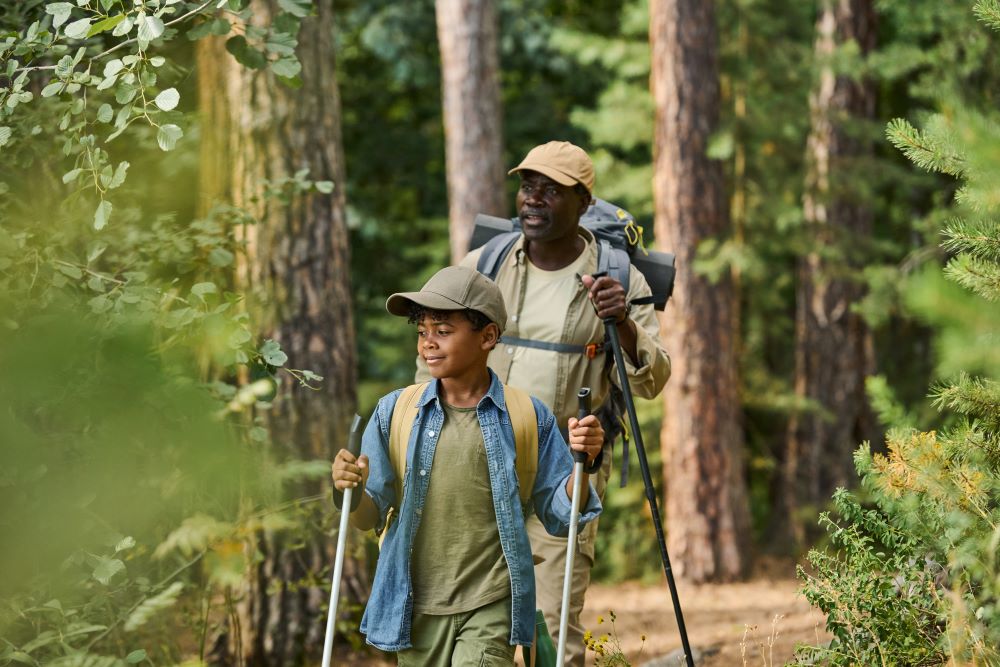Jackson Demonstration State Forest
Jackson is the largest of CAL FIRE's fourteen demonstration state forests. The area has a long history of logging which began under private ownership 1862, then evolved into sustainable harvesting after the State's purchase of the property in 1947. Today, more forest growth occurs each year than is harvested. The most common tree on the forest is coast redwood, but visitors will also find Douglas-fir, grand fir, hemlock, bishop pine, tanoak, alder, madrone, and wax myrtle.
Forest Stats:
Established: 1949
Area: 48,652 acres
Elevation: 80 - 2,200 ft
Precipitation: 39 in per year along coast
70 in per year inland Temperature: Max: 100 F - Min: 25 F
JDSF Base Map - Compatible with mapping apps (e.g. Avenza).
Research
Demonstration
Recreation
- JDSF Modernization Vision 2022
- JDSF Annual Report 2023
- JDSF Annual Report 2022
- JDSF Annual Report 2021
- Current and Previous Editions of the Monthly JDSF Newsletter
- JDSF and Carbon
- How Much Does JDSF Harvest and What that Means for Carbon and Mendocino Economy
- JDSF Role in Climate Change within the Redwood Region
- JDSF Fire Protection and Pre-Attack Plan
Community Events
Recreation, Maps and Trail Information
California Department of Public Health Warning on deadly mushrooms
JDSF maintains a rustic experience, so be aware of minimal signage no cell signal. It is recommended to carry a cell phone with an application like TrailForks or Avenza loaded with a copy of the JDSF Base Map before venturing into the forest. All digitized maps are georeferenced and available for use offline (cell reception not required) in the Avenza app.
Hiking: Three demonstration trails have been developed with trail guides to inform visitors about the ecology, history and management of the redwood forest. There is also numerous hiking trails situated in historically and ecologically interesting settings, such as the Waterfall Grove Trail and the Forest History Trail.
Biking: There are many opportunities for all types of bikers to explore JDSF. Mountain and gravel biking has grown in popularity. There are a vast number of dirt and gravel roads providing connector routes to ridge lines, streams, and forested areas. There are multi-use single tracks on JDSF, mostly located within the Caspar and Big River drainages, some connecting with neighboring public lands, including Big River and Woodland State Parks.
Horse Back Ridingg: The equestrian public enjoys access to thousands of acres of forest on the many miles of seasonal logging roads found at JDSF. For the last 20 years, several competitive endurance and trail riding clubs have utilized these roads to hold group ride events with challenging terrain. There is one designated horse camp open to the public from late spring to early fall, located off JDSF Road 810, near the Camp 20 Day Use Area. There are several locations to park, including the popular Camp One Day Use Area and adjacent to the Little Red School House, just off Hwy 20. The following maps illustrate these areas, including suggested routes.
- Suggested Horse Route Map – Camp One Area
- Suggested Horse Route Map – Horse Camp near Little Red School House
Hunting & Fishing: Hunting is allowed in season. No fishing is allowed per CA Department of Fish and Wildlife rules.
Firewood Cutting and Mushroom Collecting: Permits are required for firewood cutting and mushroom harvesting. Mushroom permits are issued on a Fiscal Year basis i.e. July 1 through Jun 30; all permits expire on June 30th regardless of when they were issued. Example: a permit issued January 18, 2024, expires June 30, 2024. A permit purchased July 1, 2024, will expire on June 30, 2025.
All Permits by mail only at this time.
Related Links:
Camping: Seasonal camping is offered mid-May through September, weather dependent. There are two main overnight camping areas with a number of campsites, including equestrian camps. Camping is within designated campsites only (i.e., dispersed camping is not allowed). Camping fees are collected at self-registration stations located in the campground, cash or check only. Camping fees will be used to support the recreation program including costs associated with maintenance and improvement of campgrounds and facilities, signage, roads, trails, etc. Campsites have picnic tables, fire rings, and pit toilets. Campers may collect dead wood lying on the ground for use within their campfire rings. There is no water at the campsites or day use areas. Pets are allowed but must be on a leash.
Permits:
- Mushroom Permit Information (PDF) BY MAIL ONLY- Allow 10-14 days
- Mushroom Permits cannot be issued in person; Priority Mail through the USPS can expedite receipt of the permit
- Special Use Permit (PDF)
- Contact our office (707) 964-5674 for questions related to recreation events requiring Special Use Permits such as organized bike and equestrian rides and races.
Cautions:
Recreation Visitor Survey: Personnel from CAL FIRE along with local stakeholders recognize the need to update recreation management planning. In 2013, a contract with a researcher at California Polytechnic State University, San Luis Obispo, was initiated to conduct a recreation visitor survey. This visitor survey was developed in collaboration with Jackson Demonstration State Forest (JDSF) managers and with input from members of the Recreation Task Force (RTF) and the Jackson Advisory Group (JAG). Subjects completed a questionnaire in three general regions of the forest, including campgrounds, day use areas and trailheads. Primary recreational activities on JDSF include camping, hiking, horseback, riding, mountain biking, firearm target shooting and picnicking. In brief, findings suggested that visitors are satisfied with most facilities and services and overall conditions are generally acceptable. Results indicated need for signage, bathroom maintenance, trail system improvements and additional personal and non-personal information services. Support for a volunteer program and camping reservation system and road access.
The finding within the report were a basis for developing the current 2016 JDSF Recreation Management Plan. The report highlighted areas of concern, in addition to the activities, services and facilities that CAL FIRE is managing well. As demographics and recreational uses change, JDSF will continue monitoring policies, decision making, planning and strategies to manage the complexities of the forest while meeting visitor recreation needs. JDSF is planning to conduct a new survey scheduled to begin in the next few years.
Charter & Membership Resources:
JDSF Recreation Task Force Meeting Materials
2025/2026
2024
- November RTF Agenda
- June RTF Agenda
- June RTF Documents
- JDSF Recreation Task Force Meetings'
- January RTF Documents
- Meeting Minutes
2023
2022
2021
Jobs in the Forest:
Activities:
Jackson Demonstration State Forest is committed to providing innovative demonstrations, experiments, and education. The nearly 50,0000 acres of forest stands of varying ages allow for landscape-level research and demonstrations to facilitate large-scale and individual projects. JDSF will demonstrate the full range of intensity of forest management while maintaining a diversity of stand conditions for future research not yet known. JDSF explicitly acknowledges that forest management is a much broader concept than the growth and yield of merchantable timber. Special concern areas such as riparian and older forest corridors, unusual plant communities, ecological processes, wildlife use of habitat corridors or structural elements, and individual species are all worthy topics for examination within the research and demonstration program.
The Caspar Creek Experimental Watershed Study was established in 1961 as a cooperative effort between the CAL FIRE and the Pacific Southwest Research Station (PSW). It is the longest continuous research project at JDSF and has important implications for forests worldwide.
Examples of recent studies on JDSF:
- Coastal Adaptive Management Experiment (AMEX)
- Adaptive Management experiment (AMEX)
- Biochar
- N5 Smoke Sensors
- Greenhouse Gas Fire Fuels Mitigation Project (PDF)
- Redwood Symposiums
- Carbon Flux Towers at JDSF
Research Partners:
California Forestry Higher Education Programs
- Cal Poly San Luis Obispo Forestry and Natural Resources
- Cal Poly Humboldt Department of Forestry and Watershed Management
- UC Berkeley Center for Forestry
List of Published Research
Jackson Demonstration State Forest (JDSF) is a 48,652 acre working forest. For over 70 years, JDSF staff have been stewards of the forest, practicing sustainable forest management while accommodating hundreds of demonstration and research projects and providing diverse recreational opportunities.
JDSF has a timber inventory of approximately 2.3 billion board feet of conifer trees that grows about 53 million board feet of timber each year. On average, JDSF harvests 14.3 million board feet of conifer timber each year which is approximately 27% of the annual growth. This conservative approach to harvesting results in significant increases in biomass (carbon sequestration) each year and over time.
Timber Harvesting Resources:
- The Jackson Demonstration State Forest Advisory Group (JAG) is an advisory body of the Department of Forestry and Fire Protection (CAL FIRE) and the Board of Forestry and Fire Protection (Board). The Mission of the JAG is to provide advice/recommendations to CAL FIRE and the Board regarding issues relevant to the periodic review of the JDSF Management Plan required under Board policy; ongoing implementation issues; and policy matters relevant to JDSF.
Charter & Membership Resources:
- 2025 JAG Member Solicitation
- Jackson Advisory Group Charter
- JAG Roster
- Bagley-Keene Guide
- Bagley-Keene and the JAG
Jackson Advisory Group Meeting Notes and Agendas:
2025
- December 2025 Meeting Documents
- December 2025 Agenda
- September 2025 Agenda
- Public Comment JAG Meeting September
- Updated Proposed JAG Meeting Dates
- June 2025 Meeting Documents
- June JAG Agenda
- March JAG Agenda
- March 2025 Meeting Documents
- Proposed JAG Meeting Dates
2024
- November 15 JAG Meeting Cancelled
- October JAG Documents
- October JAG Agenda
- August JAG Documents
- August JAG Agenda
- July JAG Documents
- July JAG Agenda
- Updated Proposed JAG Meeting Dates
- May JAG Documents
- May JAG Agenda
- Cancellation of March JAG Meeting
- Proposed JAG Meeting Dates
2023
- November JAG Documents
- September JAG Documents
- June JAG Documents
- March JAG Documents
- Proposed JAG Meeting Dates
2022
2021
Boundary Creek info available under "Timber Harvest"
2020
2019
Caspar 500 info available under "Timber Harvest"
2018
JDSF Office
802 N Main St
Fort Bragg, CA 95437
(707) 964-5674 (Main Office)
Please tell us what you think about our website. Send mail to JDSF@fire.ca.gov with questions or comments.
- Celebrating Mendocino Coho Returns
- SweetPea Trail Mountain Biking at Jackson Demonstration State Forest
- Jackson Demonstration State Forest – Using 3D Visualizations for Sustainable Forest Management
- CAL FIRE Demonstration State Forests
- Demonstration State Forest Forestry Aides
- Using Prescribed Fire to Restore Acorn Harvesting Potential


